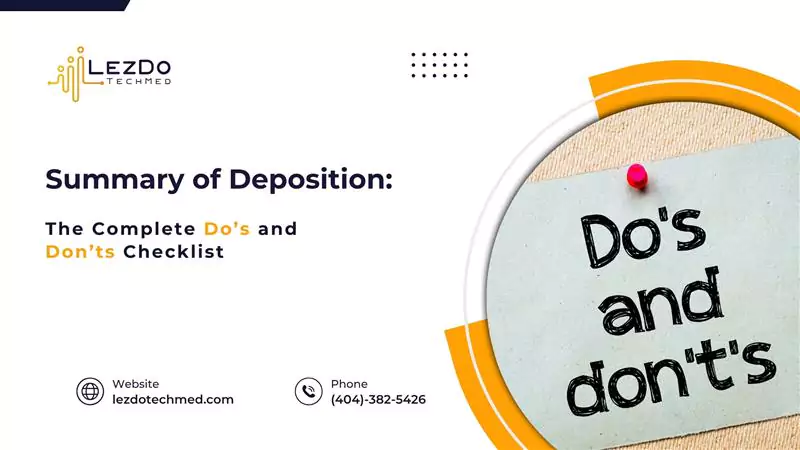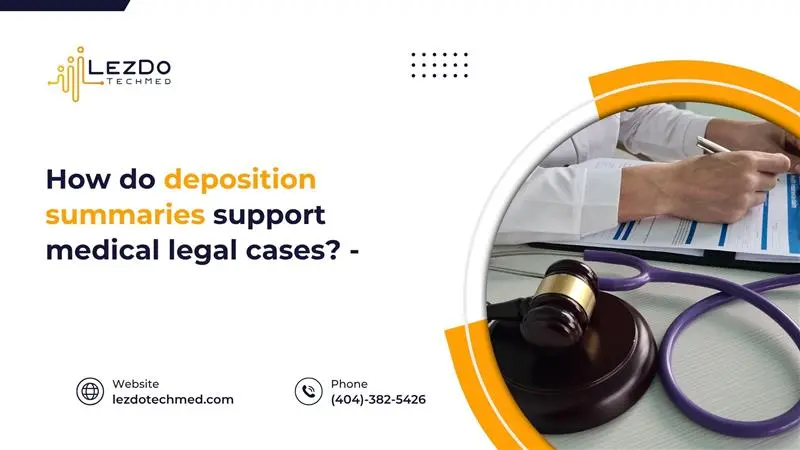If you’re an attorney, a paralegal, or a legal assistant, you know how busy your schedule can be. Reviewing a 200-page deposition transcript while ticking deadlines can be time-consuming. It can be exhausting to you as well, both physically and psychologically.
Sifting through pages of testimony to extract the key facts isn’t as easy as it seems. Legal professionals understand the challenge of identifying what truly matters while maintaining accuracy, clarity, and quality. Creating a reliable summary of deposition requires more than just reading. It demands a keen understanding of what makes testimony relevant, actionable, and strategically useful.
This guide takes you through a complete checklist of dos and don’ts to help you draft summaries that are both efficient and effective.
How to Make Your Deposition Summary Work (The Dos)
1. Focus on relevant facts
A good deposition summary doesn’t mean it captures everything that is said. It should summarize what matters most. Identifying the facts that impact liability, causation, damages, or credibility is vital.
What to include:
- Statements that support or contradict the claims and other evidence
- Important dates, timelines, and sequences of events
- Details relevant to liability, causation, or damages
- Testimony that may affect the witness’s credibility
- Mentions of prior medical conditions or injuries
Ensure that you summarize only case-relevant facts that move the case forward.
2. Organize by issue or topic
Summaries should be easy to navigate. Group testimony by topic rather than following a strict chronological order unless specifically requested. The reader should not feel like wading through unstructured information.
Helpful sections might include:
- Background of the witness
- Details of the incident
- Medical treatment history
- Prior injuries or conditions
- Contradictions or inconsistencies
Using headings, bullet points, and consistent formatting improves clarity and readability.
3. Highlight critical dates, names, and medical details
Accuracy is everything in legal documentation. A single error in a date, name, or diagnosis could mislead the entire legal team.
Always double-check:
- Claimant and witness names
- Dates of injury, treatment, and prior incidents
- Medical terminology and diagnoses
- Discrepancies between testimony and prior records
You can even consider using bold formatting to draw attention to dates and names within the summary.
4. Use neutral, objective language
Deposition summaries should never be biased or carry the opinion of the summarizer. You have to present a clear, factual account of what was said, and not interpret or assume the motive of the witness.
For example:
- Objective: “The witness stated they did not report the injury until two weeks later.”
- Biased: “The witness clearly lied about when the injury happened.”
Let the facts speak for themselves.
5. Include the facts that strengthen or weaken the case
You have to present testimonies that could help or harm the case. When you avoid harmful or damaging statements, that could make you miss the issue. This could make you unprepared when the opposition brings up the issues during the trial.
If a witness gives contradictory testimonies on different occasions or says something that weakens the claim, highlight it. This helps you plan strategies, prepare rebuttals, or assess the value of statements. When you fail to note these, you may not remember them at times of need.
6. Proofread carefully
Even spelling errors, formatting issues, and unclear sentences damage the credibility of your summary. Make sure you review the following:
- Grammar and spelling
- Consistency in tense and terminology
- Sentence structure and flow
- Proper names and page references
- Formatting consistency
- Page references and exhibits
7. Use templates to streamline the process
By using standardized templates, you can ensure consistency across summaries and speed up the workflow. If you have high-volume cases, AI tools or legal software can be useful in:
- Auto-tagging keywords
- Grouping related content
- Detecting inconsistencies in timelines
However, remember, AI tools can’t replace you entirely. You have to review it to ensure its accuracy.
What to Avoid in Summary of Deposition (The Don’ts)
1. Don’t copy and paste large content from the transcript
Copying large parts of verbatim text will spoil the purpose of summarizing depositions. It will also make the document difficult to understand.
If technical or medical jargon is too important to avoid, or without that, you cannot convey the facts, you can use it. Otherwise, condense the transcript data and deliver only crucial facts. Keep your language neutral and professional.
2. Don’t create an unstructured summary
Presenting the facts in clumsy paragraphs can make locating details difficult. Avoid:
- Long paragraphs without breaks
- Mixing unrelated topics
- Ignoring formatting practices
Even if you have a summary but a disorganized one, it can waste your time instead of saving it.
3. Don’t use complex technical jargon
Using complex terms could leave your readers perplexed. Avoid terms that:
- Obscure meaning
- Increase complexity
- Sounds biased and speculative
Choosing clear, direct, and case-relevant language can make your summary intelligible and help the entire legal team quickly understand the vital facts.
4. Don’t rush the review process
When you rush the review, your summary can be filled with gaps, inconsistencies, and errors. If the deposition was long and complex, allocate enough time to:
- Review the full deposition carefully
- Outline the structure before writing
- Draft and revise
- Ask clarifying questions if needed
A few extra hours of preparation can make a major difference in summary quality. It will make the summary more reliable and accurate.
5. Don’t ignore the needs of your reader
Every summary of deposition is created depending on the needs of the person or firm who requested it. If your summary doesn’t help them find key information quickly, it is not doing its purpose. Keep the readers in mind, know their needs, and focus your attention on the relevant details.
Check Our Samples to Experience Flawless Accuracy!
Find the work hectic? Just outsource!
Outsourcing deposition summaries helps you focus on your strategy, while experienced summarizers handle the difficult task. If you partner with the right service, you can get accurate and well-organized summaries delivered on time.
LezDo TechMed ensures every summary of deposition we create is tailored to your case-specific needs. Whether it’s one deposition or a dozen, outsourcing to our deposition summary services can streamline your workflow, reduce stress, and ensure consistency across all your files.
To put it in a nutshell, a summary of deposition is not just an abridged version of the transcript. It’s a vital document in litigation processes. If the summary process follows the right steps, it could save time, clarify testimony, and help the legal teams stay focused on important arguments.
Stick to the do’s, avoid the don’ts, and always keep your reader in mind. With practice, you’ll turn even the longest transcript into a clean, strategic, and courtroom-ready document.
Seeking High Quality Deposition Summary Service?











